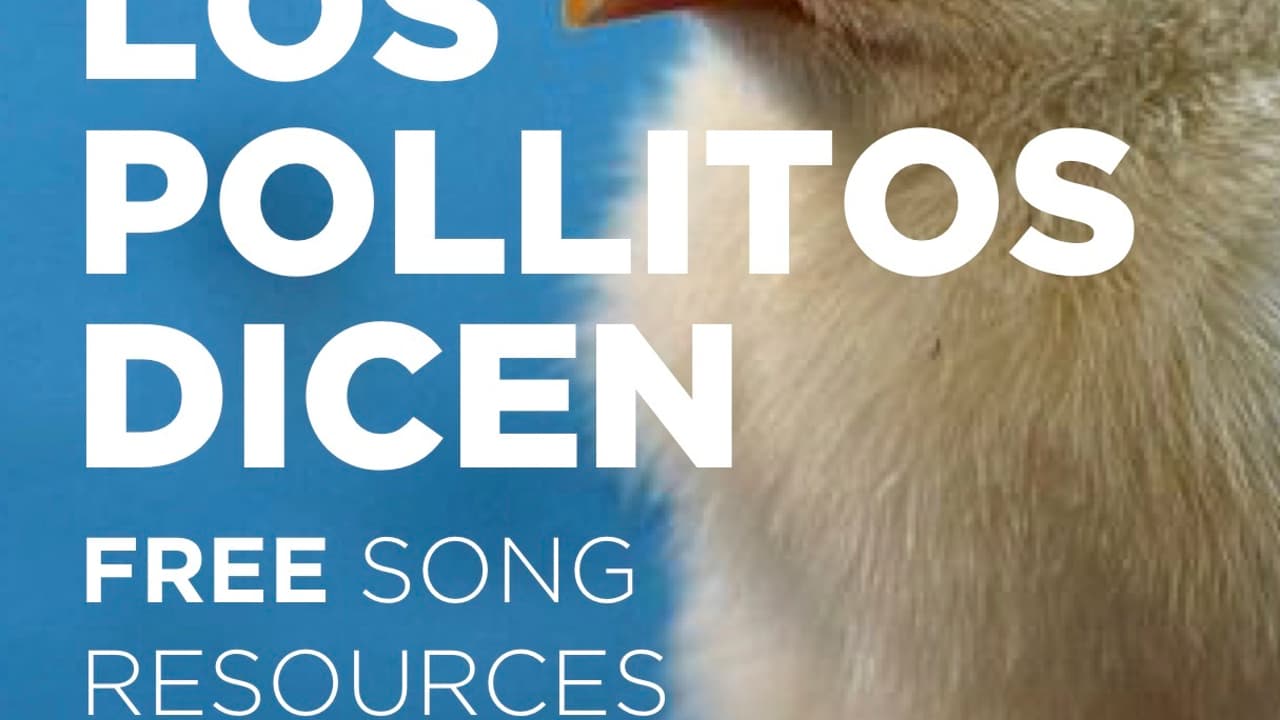I start every school year with this song. It's not the best way to acquire language, so I understand spending all of your time at the beginning of the year doing PQA and Circling with Balls and Three Ring Circuses and what-not. In my experience, though, it is such FUN to start off with a song! The kids will go home singing it, it makes a big impression, and they'll love it for the rest of the year. AND, if you teach it well, they'll still acquire some language. Download all of the resources that you need to teach this song in my FREE, complete Week 1 lesson plans for Spanish here (I also have plans for French here).  Use this version of the song: Los pollitos dicen MP3 (Track 4)
Use this version of the song: Los pollitos dicen MP3 (Track 4)
Teach these gestures: Los pollitos dicen - FLAP YOUR ARMS AS IF THEY WERE CHICKEN WINGS (not the edible kind, haha!) pío pío pío - MAKE YOUR HANDS 'TALK' BY OPENING AND CLOSING YOUR THUMB AND FINGERS TOGETHER IN A 'BLAH BLAH 'BLAH' KIND OF WAY cuando tienen hambre - RUB YOUR TUMMY LIKE YOU'RE HUNGRY cuando tienen frío - CROSS YOUR ARMS OVER YOUR CHEST AND SHIVER LIKE YOU'RE COLD La gallina busca - BRING YOUR RIGHT HAND TO YOUR FOREHEAD TO FORM A 'VISOR' AND LOOK FROM LEFT TO RIGHT as if you were searching for something el maíz y el trigo - CLASP YOUR HANDS TOGETHER WAY ABOVE YOUR HEAD (similar to the 'a' in YMCA, but perfectly straight up) these are both tall, thin plants; so you are trying to be a tall, thin stalk :) les da la comida - PUT YOUR HANDS TOGETHER IN FRONT OF YOU as though you were offering food to someone y les presta abrigo - PRETEND TO PUT A COAT OVER YOUR SHOULDERS as if someone had just loaned one to you and you are drawing it closed pío pío pío - MAKE THE TALKING MOTION WITH YOUR HAND BY PINCHING YOUR THUMB AND FOUR FINGERS TOGETHER REPEATEDLY duermen los pollitos - PUT YOUR HANDS TOGETHER NEXT TO YOUR HEAD, CLOSE YOUR EYES, AND REST YOUR HEAD ON YOUR HANDS as though you were sleeping
HOW TO TEACH THE SONG: On the board, write this with a black and blue marker: los pollitos - the little chickens dicen - (they) say
- Tell the students that they are going to learn a song called “Los pollitos dicen”. Tell them what each word means as you point to it and its translation.
- Pop-up grammar: (1) Ask if anyone notices how you are pronouncing the double L in ‘pollitos’. Affirm that the “ll” in Spanish makes the English ‘y’ sound. (2) Tell the kids that the ‘ito’ on the end of ‘pollitos’ means “little”, and it can be added to anything in Spanish to make that thing a ‘little’ thing. Give some examples by reading students’ names and adding the ‘ito/ita’ as you look them in the eye and pat their head endearingly. (3) The -n on the end of ‘dicen’ means ‘they’; whenever you see an -n on the end of a verb in Spanish, it means that ‘they’ is the subject.
- Say, “Clase”....
- Stop. Write the words for sí/yes and no/no on the board. Tell the students that whenever you say “Clase”, they must respond with a very curious/interested “¿Síiii?” so that you know that they are ready to hear what you are about to say.
- Then say “Clase” (pause and goad them into saying síiiiii...), los pollitos dicen pío pío pío.
- Stop. Tell them “Whenever I make a statement in Spanish that gives you new information about the story, it is the most interesting thing that you have ever heard. Since you think it is so interesting, you gasp/ooh/ahh/etc. Then practice.
- Continue...Clase, “Los pollitos dicen pío pío pío» (Wait for their interested response....”oooh!”).
- Circle the statement with a few yes/no or either/or questions, but before you introduce new variables, ask the students, “In English, what DO little chickens say?” Wait for someone to say “peep peep” (you may need to help). Then explain that there is a different word for what chickies say in Spanish. Say “En español, los pollitos dicen «pío pío pío»” (point to each part of the sentence and its translation as you say it).
- Continue Circling the statement “Los pollitos dicen «pío pío pío»” Compare it to sounds that other animals make (muu, cucurucú, etc.), and what students in the class say.
- Pull up the “Los Pollitos Dicen” slide.
- Show each slide one at a time. Let the kids see what each line means in English--don’t ask them! It will just make it take longer, and they’ll probably be wrong, anyway. Don’t spend time circling and personalizing anything but the first line: Los pollitos dicen pío pío pío. Just have the kids repeat after you and do the gesture. (Although let them know that if they are not comfortable speaking in Spanish yet, they don’t have to repeat for this song.) Above all, keep an eye on the clock. Make sure you leave enough time in the class period to actually sing the song AND to take pictures.
- After you’ve read each slide, show students the gesture for that line (gestures are on song post linked above).
- After you’ve gone through all of the slides....(a) Go through them once more, quickly, with gestures, if you have time, or (b) If you don’t have time to read through them again, have students stand up. Play the song and require that they gesture along with you...and allow them the choice of singing or not. Sing through the song twice. Show the singalong (linked above) instead of the powerpoint so that you are free to gesture along with them instead of having to click through each slide.



